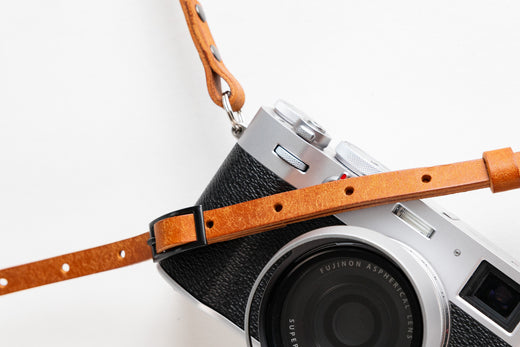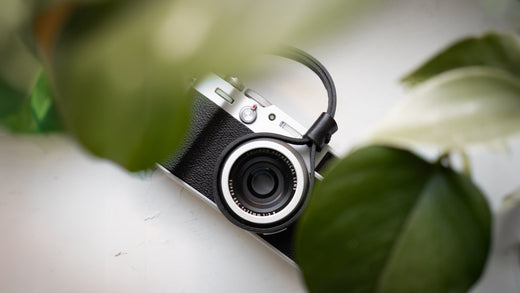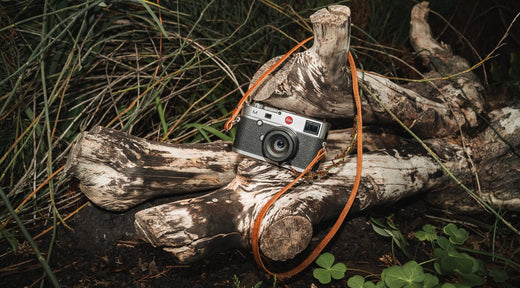
How to Choose the Right Camera Strap?
Different camera types, such as DSLRs, mirrorless cameras, and vintage film cameras, vary significantly in size, weight, and usage, which means they often require different types of straps to ensure comfort, functionality, and safety. Using the right strap tailored to your specific camera type can greatly enhance shooting comfort and reduce the risk of accidents. Here’s why:
1. Weight Distribution and Support
Heavier Cameras (e.g., DSLRs):
DSLR cameras, especially those equipped with large lenses or additional accessories, can be quite heavy. For these setups, a wider, padded strap is ideal as it distributes the weight evenly across your shoulder or neck, reducing strain and fatigue. Wider straps are also less likely to dig into your skin, making them more comfortable for extended shoots.
Lighter Cameras (e.g., Mirrorless and Compact Cameras):
Mirrorless and compact cameras are generally lighter and more portable, so they don’t require as much support. A narrower, lightweight strap is often sufficient, providing ease of movement and quick access to the camera. These straps are less bulky and allow for greater flexibility, which is particularly beneficial for street or travel photography.
2. Size and Attachment Mechanisms
Large Camera Bodies (e.g., DSLRs and Medium-Format Cameras):
Larger cameras often come with standard strap lugs designed to accommodate thicker, more robust straps that can securely hold the weight. These straps typically have reinforced stitching and metal hardware to handle the load. Using a strap that’s too thin or has weak attachments can be dangerous, as it may not support the camera properly, increasing the risk of accidental drops.
Smaller Cameras (e.g., Mirrorless, Point-and-Shoot, Vintage Cameras):
Smaller cameras often have smaller attachment points that may not be compatible with wider or heavier straps. They benefit from thinner, more compact straps with smaller attachment rings. Using an oversized strap can be cumbersome and may even damage the camera’s attachment points, so it's crucial to use a strap that fits securely and comfortably.
3. Shooting Style and Accessibility
Quick-Access Needs (e.g., Street Photography, Photojournalism):
Photographers who need to react quickly, like street photographers or photojournalists, benefit from straps that allow rapid camera access, such as cross-body or sling straps. These straps let the camera hang comfortably at the side and can be swiftly lifted to eye level for fast shooting. Choosing the right strap for these scenarios can make the difference between capturing or missing a critical moment.
Stability and Control (e.g., Studio, Landscape Photography):
In studio or landscape settings, where photographers need stability and precision, a shorter, fixed-length strap or even a wrist strap is preferable. This type of strap minimizes camera movement and provides better control during setup and composition. It also reduces the risk of the camera swinging or bumping into objects, which can happen with longer, more flexible straps.
4. Comfort for Extended Use
Long Shoots and Events (e.g., Weddings, Sports Photography):
For photographers covering long events or shooting for extended periods, ergonomic straps with extra padding or cross-body designs are essential. These straps distribute the camera’s weight more evenly, preventing neck and shoulder strain. They also often feature quick-release mechanisms, making it easy to switch between carrying styles or detach the camera when needed.
Travel and On-the-Go Photography:
When traveling or shooting on the move, compact and lightweight straps are preferable as they don’t add bulk to your gear. Straps with anti-slip or anti-theft features are also beneficial, providing both comfort and security when navigating crowded or unfamiliar environments.
5. Safety and Security
Using the right strap for your camera type is not only about comfort but also safety. A strap that is too weak or improperly secured can result in accidents, damaging both the camera and potentially causing injury. High-quality straps designed for your camera’s weight and attachment points reduce the risk of failure. For expensive or heavy gear, consider straps with additional safety features, like backup tether systems or secure locking mechanisms.
Conclusion
Selecting the right strap for your camera type is essential for optimizing shooting comfort, accessibility, and safety. Whether you're using a heavy DSLR, a nimble mirrorless camera, or a delicate vintage model, a well-chosen strap can significantly enhance your shooting experience, allowing you to focus on your photography without discomfort or worry about equipment safety.



